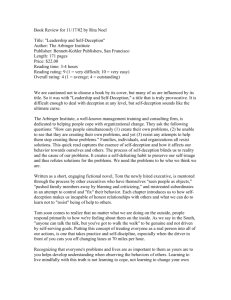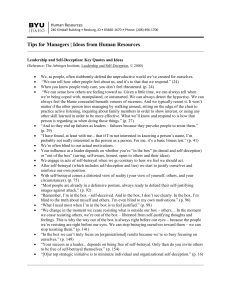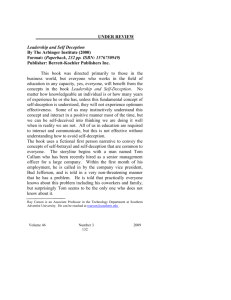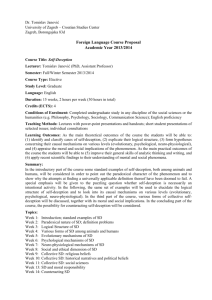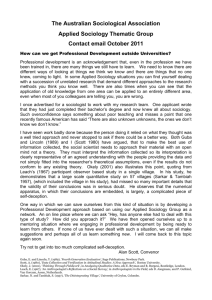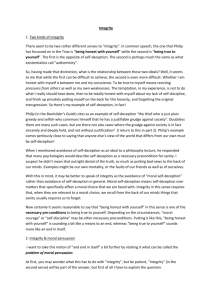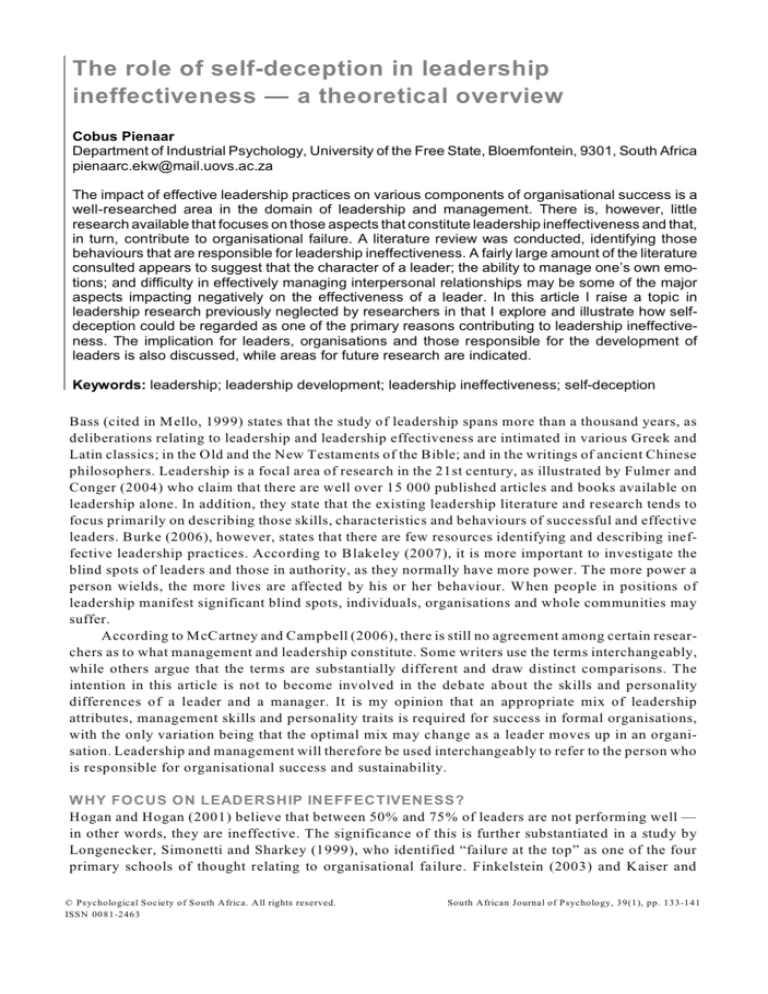
The role of self-deception in leadership
ineffectiveness — a theoretical overview
Cobus Pienaar
Department of Industrial Psychology, University of the Free State, Bloemfontein, 9301, South Africa
pienaarc.ekw@mail.uovs.ac.za
The impact of effective leadership practices on various components of organisational success is a
well-researched area in the domain of leadership and management. There is, however, little
research available that focuses on those aspects that constitute leadership ineffectiveness and that,
in turn, contribute to organisational failure. A literature review was conducted, identifying those
behaviours that are responsible for leadership ineffectiveness. A fairly large amount of the literature
consulted appears to suggest that the character of a leader; the ability to manage one’s own emotions; and difficulty in effectively managing interpersonal relationships may be some of the major
aspects impacting negatively on the effectiveness of a leader. In this article I raise a topic in
leadership research previously neglected by researchers in that I explore and illustrate how selfdeception could be regarded as one of the primary reasons contributing to leadership ineffectiveness. The implication for leaders, organisations and those responsible for the development of
leaders is also discussed, while areas for future research are indicated.
Keywords: leadership; leadership development; leadership ineffectiveness; self-deception
Bass (cited in Mello, 1999) states that the study of leadership spans more than a thousand years, as
deliberations relating to leadership and leadership effectiveness are intimated in various Greek and
Latin classics; in the Old and the New Testaments of the Bible; and in the writings of ancient Chinese
philosophers. Leadership is a focal area of research in the 21st century, as illustrated by Fulmer and
Conger (2004) who claim that there are well over 15 000 published articles and books available on
leadership alone. In addition, they state that the existing leadership literature and research tends to
focus primarily on describing those skills, characteristics and behaviours of successful and effective
leaders. Burke (2006), however, states that there are few resources identifying and describing ineffective leadership practices. According to B lakeley (2007), it is more important to investigate the
blind spots of leaders and those in authority, as they normally have more power. The more power a
person wields, the more lives are affected by his or her behaviour. W hen people in positions of
leadership manifest significant blind spots, individuals, organisations and whole communities may
suffer.
According to McCartney and Campbell (2006), there is still no agreement among certain researchers as to what management and leadership constitute. Some writers use the terms interchangeably,
while others argue that the terms are substantially different and draw distinct comparisons. The
intention in this article is not to become involved in the debate about the skills and personality
differences of a leader and a manager. It is my opinion that an appropriate mix of leadership
attributes, management skills and personality traits is required for success in formal organisations,
with the only variation being that the optimal mix may change as a leader moves up in an organisation. Leadership and management will therefore be used interchangeably to refer to the person who
is responsible for organisational success and sustainability.
W HY FOCUS ON LEADERSHIP INEFFECTIVENESS?
Hogan and Hogan (2001) believe that between 50% and 75% of leaders are not performing well —
in other words, they are ineffective. The significance of this is further substantiated in a study by
Longenecker, Simonetti and Sharkey (1999), who identified “failure at the top” as one of the four
primary schools of thought relating to organisational failure. Finkelstein (2003) and Kaiser and
© Psychological Society of South Africa. All rights reserved.
ISSN 0081-2463
South African Journal of Psychology, 39(1), pp. 133-141
134
Cobus Pienaar
Kaplan (2006) reiterate this when they state that it is leaders and managers (and by implication the
behaviour of these individuals) who are responsible for organisational failure. This coincides with
an observation made by the editor of Business Horizons who states that corporate scandals across
organisational types and country boundaries are the result of leadership failure (Business Horizons,
2004). In order to understand organisational failure, the focus should be expanded to include
identifying those aspects and behaviours of leaders who are considered ineffective. McCartney and
Campbell (2006) express concern that there is a paucity of studies exploring leadership ineffectiveness. Studying leadership ineffectiveness — referred to by Ready (2005) as derailments —
creates a better understanding of why leaders fail. Crosbie (2005, p. 47) accentuates the fact that
defects and weaknesses matter, as indicated in the following statement: “Success depends not only
on moving steadily forward but on preventing derailment. Preventing derailment means going
beyond nourishing strengths and attending to flaws”. The preceding idea is reiterated by Dotlich and
Cairo (2003) who state that the most successful leaders are those who learn to manage their derailers.
This theoretical overview raises a topic in leadership research previously neglected by researchers,
in that it attempts to explore and illustrate how self-deception may contribute to leadership ineffectiveness. The single biggest “derailer” as suggested by Jordan (2003), may be leaders’ inability to
see how they themselves contribute to the problem they blame others for.
OVERVIEW OF THE LITERATURE
The electronic databases that were consulted for the purpose of the literature review include Business
Source Complete, Psych Articles, and Psych Info. Only texts published in English were included in
the database search. Of all the texts yielded by this search, only those that addressed leadership
ineffectiveness, leadership failure, self-awareness, self-deception and leadership ineffectiveness were
included for the review. The reference lists in the articles yielded were also consulted for other relevant literature, which may not have been considered otherwise. A search was also carried out on the
Internet, focusing explicitly on the concept of leadership and self-deception. Only a small amount
of research, studies, and information focusing on the interplay between leadership ineffectiveness
and self-deception was available. The literature overview that follows intends to explore explicitly
some of the available literature focusing on leadership ineffectiveness and the role that self-deception
may play in this regard.
Leadership ineffectiveness
Leadership ineffectiveness in this article, as used by previous authors, refers to those observable and
unobservable behaviours and by implication personal qualities and character of leaders that make
them ineffective. The following literature serves as proof of the complexity of the task of trying to
describe and illustrate all those aspects of ineffective leadership; in other words, compiling one
acceptable definition for leadership ineffectiveness. It also provides evidence for the lack of definitions specifically focusing on leadership ineffectiveness.
According to Burke (2006), there are certain themes emerging from the literature focusing on
leadership ineffectiveness. The first theme is associated with the inability of a leader to develop
effective interpersonal relationships due to a lack of interpersonal skills. The leader may be arrogant,
stubborn, and/or egocentric. McCartney and Campbell (2006) identify failure in maintaining satisfactory interpersonal relationships as the most frequently cited reason leading to leadership ineffectiveness within an organisation. Specific problems include abrasive behaviour towards others.
Leaders with these problems have also been found to lack the ability to balance and maintain interpersonal relationships with a variety of constituencies simultaneously. Problems related to interpersonal relationships include the inability to build a team, difficulty in moulding and shaping employees into a team, and difficulty in resolving conflict among team members. The importance of
interpersonal skills is further emphasised by Crosbie (2005) who refers to a study conducted by
Harvard University, the Carnegie Foundation and the Stanford Research Institute. It was found that
technical skills and knowledge account for about 15% of the reasons why an individual finds, keeps
Self-deception in leadership ineffectiveness
135
and advances in a job. The remaining 85% of job success is based on a person’s people skills. Babiak
and Hare (2006) indicate that more executives are dismissed for “personality problems” than for
incompetence. The second theme suggested by Burke (2006) revolves around leaders who are afraid
to take risks and make errors. These leaders are cautious and avoid responsibility. Third, excitable
individuals (characterised as impatient, moody, negative, volatile, and emotionally unstable) are
thought to contribute to ineffective leadership behaviour. Finally, skepticism and distrust as cited by
Lubit (in Burke, 2006) reduce a leader’s effectiveness even more, especially when it comes to
motivating others. These leaders are cynical and untrustworthy.
McCall and Lombardo (cited in Burke, 2006) identified an insensitive, abrasive, or bullying
style; aloofness or arrogance; betrayal of personal trust; self-centred ambition; failure to constructively address an obvious problem; micromanagement; an inability to select good subordinates; inability
to take a long-term perspective; inability to adapt to a leader with a different style; and overdependence on a mentor as the ten most common causes of leadership ineffectiveness. Finkelstein
(2003) found that leaders who presided over major business failures viewed themselves and their
companies as the major role-player in their environments; they had an over-optimistic and overestimated view of how much control they had over events (they thought that they and their
organisations were successful because of themselves); they thought they had all the answers (they
were often fixated on being right and in control); they were not good listeners and would not accept
advice or suggestions (any disagreement/opposition would be pushed aside); they would eliminate
any critics; they were obsessed with the company’s image in the public eye; they felt an enormous
need to be right; and it was difficult for them to integrate change, as they would normally adhere to
what had worked for them in the past. In addition, Gunn (2006) suggests that a leader’s self-interest,
where a leader seems to engage in activities that merely serve personal interests without considering
the well-being of others, impact negatively on a leader’s effectiveness. This ties in with the view of
Hogan (1994) who states that people in general are prone to selfishness and genetically programmed
towards egocentrism, which, if not attended to, will by default result in selfish behaviour (overtly and
covertly). According to Ruderman, Hannum, Leslie and Steed (2001), leadership ineffectiveness is
coupled with struggles to build relationships with others based on trust. They identify the belittlement
and humiliation of co-workers; the exhibition of arrogance, abusiveness, and abrasiveness; difficulty
managing emotions; angry outbursts; verbally abusing co-workers; lack of compassion and empathy;
and difficulty understanding oneself and others. Dotlich and Cairo (2003) identify 11 derailers which
they consistently found in CEOs and senior leaders who were deemed ineffective. The following
derailers are characteristic of unsuccessful leaders: arrogance (when the leader holds the opinion that
he or she is right and everybody else is wrong); melodrama (when leaders strive to be the centre of
attention); volatility (the mood swings of a leader, which drive business swings); excessive caution
(the inability of a leader to take action when necessary); habitual distrust (a tendency to focus on
negatives); aloofness (disengagement and disconnection from people); mischievousness (a tendency
to break rules); eccentricity (portraying an image that is extremely different just for the sake of it);
passive resistance (when silence is misinterpreted as agreement); perfectionism (focusing on perfecting the little things even when big things go wrong); and eagerness to please (where the focal point
is to win the popularity contest).
The literature cited above suggests that the character of leaders, difficulty managing their own
emotions, and difficulty managing interpersonal relationships are some of the major aspects impacting negatively on their effectiveness. According to Burke (2006), a leader’s character determines
how such an individual will ultimately lead an organisation, though business knowledge and managerial skill also seem to impact on effectiveness. This coincides with Goleman’s IQ and EQ argument, which suggests that awareness of others and one’s own emotions and behaviour may be as
important as (cognitive) intelligence (Goleman, 1995; Ruderman, Hannum, Leslie, & Steed, 2001).
Blakeley (2007), Donlon (2006) and Dotlich and Cairo (2003) reiterate this by stating that to be an
effective leader one requires more than an understanding of pricing in global markets or knowledge
of one’s competitors. According to these authors, the complete leader is not merely a technocrat with
136
Cobus Pienaar
deep skills in operations, finance or sales and marketing. The key to leadership success lies in the
ability to work through teams and to develop a culture of trust with others — i.e. to build relationships. At its root, the primary job of leadership according to Goleman, Boyatizis and M cKee
(2002) is emotional. Though often invisible or ignored entirely, emotions determine whether everything else a leader does will work as well as it could. Success therefore depends more on how you
do it, than on what you do. Dotlich and Cairo (2003) are of the opinion that many leaders sabotage
themselves, albeit unconsciously. They have the intellect, skills and experience to lead their companies through whatever challenges may arise, yet for some reason they are unable to do so.
Something derails their best efforts — something integral to who they are, both as people and as
leaders — and that operates beneath their awareness.
The role of self-deception in leadership ineffectiveness
The single biggest “derailer” suggested by Jordan (2003), and investigated in this article, is leaders’
inability to see how they themselves contribute to the problems they blame others for, namely,
self-deception. Goleman (1985) is of the opinion that self-deception may be one of the biggest
paradoxes of our time, since those with power (leaders in this instance) are too comfortable to notice
the pain of those who suffer, while those who suffer, have no power.
Kaplan (2003) suggests that self-deception may in extreme instances even directly or indirectly
be responsible for the death of people. Kaplan refers to the case of Dr Radovan Karadzic who stands
indicted as a suspected war criminal for crimes against humanity and genocide. Karadzic is accused
of a multitude of war crimes, including the indiscriminate murder of civilians and the murder of up
to 7 500 people at the “safe haven” of Srebrenica. According to Kaplan (2003), Karadzic’s personality remains a mystery. His most obvious characteristics are, however, his impressive self-image, being
reckless, irresponsible, and opportunistic, and suffering from complete self-deception (which is
argued to be negatively associated with leadership effectiveness).
This leads to the question of how self-deception may affect a leader’s effectiveness. In order
to ensure leadership effectiveness, it is important to investigate, theoretically illustrate, and explain
how self-deception may be one of the root causes contributing to leadership ineffectiveness. This will
be explored in the following sections.
W hat is self-deception?
Self-deception refers to a process of denying or rationalising away the relevance, significance, or
importance of opposing evidence and logical arguments (Wikipedia, 2006). Goleman (1985, p. 13)
sees self-deception as the most elusive of all mental facts. The author states it as follows in his own
words: “W e do not see what it is that we do not see.” The Arbinger Institute (2002) defines selfdeception as the state of not knowing and resisting the possibility that there is a problem, while one
may be the problem oneself. The following narrative, taken from the book Leadership and Selfdeception (The Arbinger Institute, 2002), illustrates the concept of self-deception:
Semmelweis, an obstetrician working at Vienna’s General Hospital during the 1800s, tried to
get to the bottom of the high mortality rate among women in the maternity ward. In the section
where Semmelweis practised, the mortality rate was one in ten. Conventional medical science
at that time called for separate treatment procedures for each symptom. Inflammation meant
excess blood was causing swelling — so they bled the patient or applied leeches. They treated
fever the same way. Trouble breathing meant the air was bad — so they improved ventilation.
But nothing worked. Patients begged Semmelweis to move them to another ward where the
mortality rate was 1 in 50. Semmelweis became obsessed with the problem: ‘W hy was the
mortality rate different in the other ward?’ The only obvious difference between the sections
was that Semmelweis’s section was attended by doctors, while the other section was attended
by midwives. Then something happened — Semmelweis took a four-month leave to visit another hospital. On return he discovered that the death rate dropped significantly in the ward
where he practised during his absence. W hy? Remember, Vienna Hospital was a teaching and
Self-deception in leadership ineffectiveness
137
research hospital. Many of the doctors split their time between research on cadavers and
treatment of live patients. They hadn’t seen any problem with that practice, because there was
as yet no understanding of germs. All the doctors knew about at that stage were symptoms.
After further researching this phenomenon he concluded that ‘particles’ from cadavers and other
diseased patients were being transmitted to healthy patients on the hands of their physicians. So
he immediately instituted a policy requiring physicians to wash their hands thoroughly in a
chlorine and lime solution before examining any patient. The results were astonishing; the
mortality rate immediately fell to 1 in 100. The doctors were unsuspectingly the carriers of the
disease that led to the death of their patients ( p. 17-19).
The preceding narrative serves as a good analogy for some of the leadership problems currently
experienced within organisations. It parallels leadership in organisations, where leadership is
sometimes the carrier of the problem (germs) without even realising or knowing it. Although “germs”
are invisible, this does not mean that they do not exist. Their very invisibility makes them so dangerous. Similarly, self-deception might well be the biggest “germ” causing leadership ineffectiveness,
without the leader even realising its contribution to the problem.
The different components of self-deception
Blakeley (2007), De Vries (2006) and Goleman (1985) are of the opinion that the interrelated
psychological processes of mental schemas, favoured defence mechanisms and cognitive dissonance
may well be components of self-deception, as they set bounds on the range of an individual’s
thoughts and feelings, which may limit their freedom of perception and action in order to feel at
peace.
In contrast to this, The Arbinger Institute (2002) sees self-deception both as the product of a
person’s “self-betrayal” and such a person’s “way of being”. Self-betrayal is an act contrary to what
individuals (leaders in this instance) feel they should do for others. W hen leaders have a sense of
what another person may need and they go against it, they ultimately betray themselves. According
to The Arbinger Institute (2002), people who betray themselves are also more likely to superimpose
the faults of others, blame others for situations or circumstances, feel like victims, exaggerate the
values that are important to them, be concerned about right and wrong, and be consumed with themselves in order to justify their behaviour, actions and thoughts. These behaviours associated with
self-betrayal show similarities with those behaviours that are associated with ineffective leadership
and which have been highlighted elsewhere in this article. It therefore seems that self-betrayal may
be one of the underlining causes of ineffective leadership behaviours. The Arbinger Institute (2002)
illustrates how leaders during self-betrayal may invite the very same thing that they complain about,
sustaining and compounding the very same behaviour they complain about in their followers.
Jordan (2003) illustrates the process previously mentioned by describing a leader who is very
demanding with regard to employees. The harsher the leader is towards the people working for him
or her, the harsher their feelings will be towards the leader. If the leader continuously points out their
flaws, becomes upset when they make mistakes and generally wonders why they cannot do a better
job, they will be watching for any mistakes the leader makes. This, in turn, will allow them to justify
their own faults, because they are not perfect either.
This leads to the next aspect of self-deception, namely, “way of being” whereby a leader has
an option to see his employees as people or as objects. The easiest way to explain “way of being”
is to consider the differences in how the following two types of leaders behave. Some leaders, have
the capacity to inspire devotion and commitment in others, even when they are interpersonally
clumsy. The fact that they have not attended many seminars or learned the latest techniques on
effective leadership hardly matters. They have the ability to inspire those around them to be all they
can. They do not always say or do the “right” things, but people love working with them and they
always achieve results through people. The other type of leader seemingly does all the “right” things
interpersonally, but people do not trust them — even if they apply all the latest skills and techniques
to communicate effectively. People ultimately resent them and their tactics. They fail as leaders
138
Cobus Pienaar
because they provoke people to resist them. Despite what leaders do on the outside, people (employees) respond primarily to how leaders “feel” about them (The Arbinger Institute, 2002). Dotlich
and Cairo (2003) support the idea that people have a notion of how leaders feel towards them and
react to this.
Employees can usually sense when leaders treat them primarily as objects..Given a little time
and experience, people can tell when there is no real feeling behind a leader’s behaviour or words,
when they are being manipulated or outsmarted, or when their interests are not really at stake; in
other words, when they are being treated as objects to serve a particular purpose. It would not matter
if a leader tried to manage by walking around, sitting on the edge of a chair to practise active listening, inquiring about family members in order to show interest, or by using any other skill learned in
order to be more effective. It would not matter if such a leader did all the “right” things interpersonally, even applying all the latest leadership skills and techniques to their communications and
tasks. People ultimately resent them and their tactics. They fail as leaders because they provoke
resistance in people. Employees respond primarily to the ways in which leaders behave towards
them, and not necessarily to the words that leaders sometimes use in order to try to impress followers.
One of a leader’s biggest blind spots is their inability to see what happens when they view and
behave towards followers as if they were objects (The Arbinger Institute, 2002).
Some leaders miss personal dynamics in the workplace because they always focus on business.
For example, they only notice employees facing distress when it is brought to their attention by
someone else. This is another simple example of employees being treated as objects by leaders. In
these situations, leaders do not see things that may be important to maintaining close personal
relationships with their employees. It is partly a lack of attention and alertness, and partly the trap
of self-deception.
SELF-AW ARENESS: THE KEY TO COM BATING THE SELF-DECEPTION TRAP
Burke (2006) shows that the higher a person progresses in an organisation, the more self-awareness
is required. Bennis and Nanus (as quoted by Morden, 1997) confirm this when they identify selfawareness, self-knowledge, awareness of limitations in self and others, and the ability to recognise,
learn and profit from failures and mistakes as some of the key leadership qualities which contribute
to leadership effectiveness. Burke (2006) asserts that the higher a person rises in an organisation, the
more self-awareness is at the centre of leadership development. The author therefore constitutes and
argues that self-awareness is an important personal ingredient affecting whether leaders would be
able to recognise or willing to look at their own self-deception practices and behaviour and that
self-awareness is necessary to function at higher levels in an organisation. It is therefore important
that leaders focus on becoming more self-aware.
In many leadership programmes, the focus is likely to be on skills and how to become an effective leader, while the next leadership development programme might concentrate on brushing up
interpersonal skills, such as effective communication where leaders practice effective listening. A
third programme might deal with situations where they need to become more directive leaders, and
so forth. This may explain the reason why so many leaders return to their organisations still not
transformed into the sort of leaders that people would want to follow. After a few weeks, or even a
few days, some leaders tend to fall back into their comfort zones and the old patterns of ineffective
leadership behaviour that they exhibited before attending the programme.
Kaiser and Devries (as quoted by Kaiser & Kaplan, 2006) and Dotlich and Cairo (2003) argue
that there should be a stronger focus on the development of processes that will assist leaders to
understand the underlying drivers of their behaviour and to become more self-aware. Goleman
(1985) refers to this as a better understanding of the individual’s schemas. Self-awareness is one of
the cornerstones of emotional intelligence, and the importance of emotional intelligence in leadership
effectiveness has been highlighted elsewhere in this article (Goleman et al., 2002). In the words of
Orwell (cited in Goleman, 1985 p. 96), “Those who control the past, control the future”. According
to Goleman et al. (2002), self-aware leaders are more likely to be honest with themselves and about
Self-deception in leadership ineffectiveness
139
themselves, and are better equipped to understand their values, goals and dreams. Leaders who are
self-aware are more likely to act with real conviction and authenticity, which invites better relationships with others.
The above factors coincide with Hogan and W arrenfeltz’s model (cited in Kaiser & Kaplan,
2006), which implies that intrapersonal and interpersonal development deserve more attention, as
they impact on the application of leadership and business skills. For example, self-control (level 1
— intrapersonal skills) is needed to maintain effective relationships (level 2 — interpersonal skills),
which is a prerequisite for effective leadership (level 3 — building a team and guiding it). Hogan and
W arrenfeltz (cited in Kaiser & Kaplan, 2006) suggest in their work that intrapersonal skills should
be the foundation on which leadership careers should be built, because the manner in which one
manages the “self” has implications for all other aspects of managerial and leadership performance.
If a leader does not have the necessary skills to regulate emotions and impulses, this may pose
problems in interpersonal relationships, in fulfilling important leadership roles, and in applying basic
business skills (Kaiser & Kaplan, 2006).
If training does not drastically change and improve to include raising self-awareness in how
leaders might contribute to problems in their organisations, training and development may not deliver
on the results they promise. W eiss and M olinaro (2006) demonstrate this in their research when they
indicate that organisations spend considerable time, money and energy building their leadership
capacity to gain a competitive advantage, but that various approaches to building leadership capacity
are failing to hit the mark. This is illustrated by the estimate of Fulmer and Conger (2004) that
organisations in the USA spend over $50 billion a year on the development of leaders. De Vries
(2006) provides a narrative to illustrate this. “There once was a person who noticed a disturbing
bump under a rug. This person tried to smooth out the rug, but every time he did the bump reappeared. In utter frustration, he finally lifted up the rug, and to his great surprise, out slid an angry
snake” (pp.1-2). This metaphor resembles those occasions when organisations agree to leadership
development interventions and training that only deal with the behaviour and symptoms of ineffective
leadership. These programmes attempt to smooth things over, while the snake beneath — the underlying cause — keeps working its mischief. Unless training starts to pull out the “snake” and deal with
it, it will confound efforts to improve leadership efficiency and, ultimately, organisational growth.
Locander and Luechauer (2006) and Kaiser and Kaplan (2006) share the same opinion in this regard,
and state that the first step of any leadership development programme requires leaders to examine
their greatest asset and liability, namely, themselves. They also suggest that the majority of people
do not want to engage in a process that includes in-depth self-reflection, and they often ignore or
deny what they need to see when they do become aware of it. These authors also point out that
leaders are rarely trained how to explore their strengths and assets, let alone their flaws, weaknesses,
or shadow sides. According to Blakeley (2007), leaders may be reluctant to listen and learn about
themselves because it could be both painful and time-consuming.. It may seem better to put up with
“known” pain and to avoid future, “unknown” pain. De Vries (2006) supports this notion when he
points out that people in positions of power are much more likely than their subordinates to find
excuses not to engage in personal work that is emotionally painful. The reluctance of leaders to take
a hard look at themselves is supported by the societal myth that leadership is a rational endeavour.
Training in self-awareness and the underlying drivers of behaviour, Blakeley (2007) argues,
should receive necessary attention. In this regard, a study by Sala (2003) shows that higher level
employees are more likely to have an inflated view of their emotional competencies that is less congruent with the perception of others who work with them often and know them well; they probably
do not see themselves the way others view them. Kaiser and Kaplan (2006) are of the opinion that
MBA programmes — supposed to develop the leaders of tomorrow — tend to focus exclusively on
such curricula as functional business knowledge, to the neglect of deeper, harder to develop competencies such as intra- and interpersonal skills.
The inability of leaders to recognise how they contribute to problems in their organisations
(self-deception) may be a primary reason contributing to ineffective leadership and may explain why
140
Cobus Pienaar
leadership development and training programmes and initiatives are not always successful. The
Arbinger Institute (2002) is of the opinion that all leaders are vulnerable to self-deception, a deeply
ingrained human trait that influences their leadership styles and behaviours. Self-deception can be
managed or minimised only if detected; if leaders become aware of it. T here is an urgent need to
change the focus in leadership training and development to include identifying a leader’s own
self-deceptions. Leadership training and development is a billion-dollar industry worldwide, but it
should be asked whether it is effective in its current form. Organisations and those responsible for
leadership and management development should consider the effectiveness of change programmes
and training initiatives that merely focus on skills transfer on a behavioural level (Kaiser & Kaplan,
2006).
The first challenge for a leader is to become aware of how he or she contributes to the problem(s) he or she blames others for. The second challenge is to create work environments where
people are treated as people and not merely as objects. A third challenge, as indicated by Hogan
(1994), is to facilitate a more intensive development of leaders than is currently found in most
leadership training programmes. This author believes that some of the “darkside characteristics” that
contribute to leadership ineffectiveness can be changed, but only with a more intensive approach.
The paradox is to be found in the literature of Goleman (1985) who points to a particularly human
malady: to avoid anxiety, we close off crucial portions of awareness, creating blind spots. According
to Blakeley (2007), it is the responsibility of leaders to overcome their blind spots. Blind spots
contribute towards inferior decision-making, and a leader’s flawed decisions can lead to detrimental
consequences for many people.
Many of the traits that have been discussed in this article have a positive side that helps leaders
to achieve success. It is only when leaders are unaware of the trait, deny its existence, or fail to see
its downside that they encounter problems. Awareness of derailers does not mean leaders have to
dwell on how “bad” they are. Instead, it frees their strengths. W hen leaders learn how to manage their
own self-destructive traits, they allow their strengths to emerge (Dotlich & Cairo, 2003).
FUTURE DIRECTIONS
The literature therefore suggests that researchers are not necessarily in agreement on those aspects
responsible for leadership ineffectiveness and how leadership ineffectiveness may be influenced by
factors “outside” the leader. It is suggested that researchers should consider expanding leadership
research to include identifying factors that may contribute to leadership ineffectiveness and simultaneously develop a comprehensive model explaining leadership ineffectiveness. It would be valuable if researchers could determine whether lack of skills, the personality profile of a person
(character) or other aspects (not being considered yet), are better predictors for leadership ineffectiveness.
Another area of research may be to develop an instrument to measure whether self-deception
occurs or not. No instrument measures this apparently important construct. Such an instrument
should also consider identifying reasons why leaders do deceive themselves even though they realise
that it may be detrimental to their future success.
Various authors believe that self-awareness is critical to leadership effectiveness and the development of leaders. Researchers and practitioners should therefore strive to develop instruments,
programmes and processes to measure, increase and facilitate self-awareness among leaders.
Measuring the impact of self-awareness on leadership effectiveness may be considered a valuable
research area for the future, should a measuring tool be developed to measure the entire scope of
self-awareness as a construct. It would also be helpful to determine whether people have the same
capacity for self-awareness.
REFERENCES
Babiak, P., & Hare, D. H. (2006). Snakes in suits. New York: HarperCollins.
Blakeley, K. (2007). Leadership blind spots and what to do about them. West Sussex: John Wiley & Sons
Ltd.
Self-deception in leadership ineffectiveness
141
Burke, R. J. (2006). Why leaders fail: exploring the dark side. International Journal of Manpower, 27,
91-100.
Business Horizons. (2004). The editor’s chair/Of heroes and leaders, (November-December), 1-2.
Crosbie, R. (2005). Learning the soft skills of leadership. Industrial and Commercial Training, 37, 45-51.
De Vries, K. (2006). The leader on the couch: A clinical approach to changing people and organizations.
San Francisco: Jossey-Bass.
Donlon, J. P. (2006). Best companies for leaders, chief executive – December 2006. Retrieved 20 April
2007 from http://www.chiefexecutive.net/ME2/Segments/publicatons/Print.asp?Module=Publication.
Dotlich, D. L., & Cairo, P. C. (2003). Why CEOs Fail. San Francisco: John Wiley & Sons, Inc.
Finkelstein, S. (2003). Why smart executives fail and what we can learn from their mistakes. New York:
Portfolio.
Fulmer, R. M., & Conger, J. A. (2004). Growing your company’s leaders. New York: AMACOM.
Goleman, D. (1985). Vital Lies, Simple Truths: The psychology of self-deception. New York: Simon &
Schuster, Inc.
Goleman, D. (1995). Emotional Intelligence: Why it can matter more than IQ. New York: Bantam.
Goleman, R., Boyatizis, R., & McKee, A. (2002). Primal Leadership: Realizing the power of emotional
intelligence. Boston: Harvard Business School Publishing.
Gunn, R. W. (2006). Light the fire within. Strategic Finance, 8-10.
Hogan, R. (1994). Trouble at the top: Causes and consequences of managerial incompetence. Consulting
Psychology Journal, 46, 1061-1087.
Hogan, R., & Hogan, J. (2001). Assessing leadership: a view of the dark side. International Journal of
Evaluation and Assessment, 9, 40-51.
Jordan, K. (2003). Awareness: the leadership challenge. Retrieved April 20 2007 from
http://www.teamchrysalis.com/AC/V3/AC36_Leadership_Challenge.htm.
Kaiser, R. B., & Kaplan, R. B. (2006). The deeper work of executive development: Outgrowing
sensitivities. Academy of Management Learning and Education, 5, 463-483.
Kaplan, R. M. (2003). Dr Radovan Karadzic: psychiatrist, poet, soccer coach and genocidal leader.
Australasian Psychiatry, 11, 74-78.
Locander, W. B., & Luechauer, D. L. (2006). Leadership Paradoxes: It takes courage to look within. MM,
46-48.
Longenecker, C. O., Simonetti, J. L., & Sharkey, T. W. (1999). Why organizations fail: the view from the
front-line. Management Decision, 37, 503-513.
McCartney, W. W., & Campbell, C. R. (2006). Leadership, management, and derailment: a model of
individual success and failure. Leadership & Organization Development Journal, 27, 190-202.
Mello, J. A. (1999). Reframing leadership pedagogy through model and theory building. Career
Development International, 4, 63-169.
Morden, T. (1997). Leadership as competence. Management Decision, 35, 519-526.
Ready, D. A. (2005). Is your company failing its leaders? Business Strategy Review, 21-25.
Ruderman, M. N., Hannum, K., Leslie, J. B., & Steed, J. L. (2001). Making the connection: Leadership
skills and emotional intelligence. LIA, 21, 3-7.
Sala, F. (2003). Executive blind spots: discrepancies between self- and other-ratings. Consulting
Psychology Journal: Practice and Research, 55, 222-229.
The Arbinger Institute. (2002). Leadership and self-deception. San Francisco: Berrett-Koehler.
Weiss, D., & Molinaro, V. (2006). Integrated leadership development. Industrial and Commercial
Training, 38, 3-11.
Wikipedia. (2006). Self deception. Retrieved May 10 2006 from http://en.wikipedia.org/wiki/Self-deception
142

